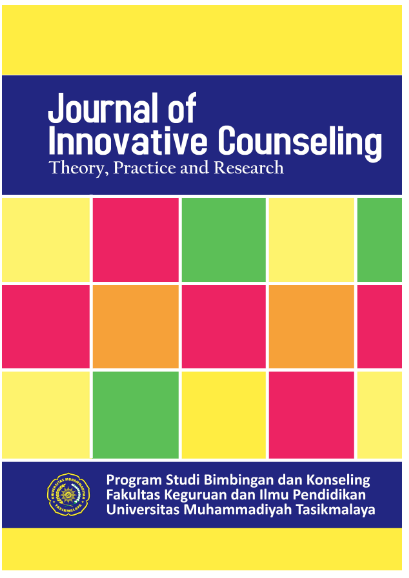Hubungan Kelekatan Dengan Tingkat Kedukaan Pada Orang Dewasa
Keywords:
grief, attachment, adultAbstract
Grief is a condition experienced when someone is abandoned by a loved
one. Attachment as a means of fostering a sense of love and affection between married couples is one of the reasons people experience grief when left by a life partner. The purpose of this study was to determine the description of grief and attachment in adults whose spouses died in Sukasukur Village, the relationship between grief and attachment, and the implications for guidance and counseling. The research method used was correlational as a way to reveal the relationship between grief and attachment. The research sample was 94 adults where every member of the population was sampled based on sampling using saturated sampling technique. The results of this study are an overview that shows a high attachment of 98%, while grief is in the moderate category at 53%. There is also a correlation between attachment and grief of 0.941 which means that both have a very high relationship.
Downloads
References
Ainsworth, Mary D. Bell, Silvia M. 1970. Attachment, Exploration, And Separation: Illustrated by the Behavior of One Year Old in A Strange Situation. Child Development, 41(1), hlm:49-67.
Alwisol. 2009. Psikologi Kepribadian. Malang: UMM Press.
Arizmendi, Brian J. O’Connor, Mary-Frances. 2015. What is “Normal” in Grief? Australian Critical Care, 28(2), 1-5. Arizmendi, Brian J. O’Connor, Mary-Frances. 2015. What is “Normal” in Grief? Australian Critical Care, 28(2), 1-5. Benoit, Diane. 2004. Infant-Parent Attachment: Definition, Types, Antecendents, Measurement and Outcome.
Podiatry Child Health, hlm: 541-545
Bhattacharya, Bidita. 2014. Cognitive Behavioural Intervention in Prolonged Grief Reaction: Case Series. Springer. Bowlby, John. (1988). A Secure Base Parent-Child Attachment and Healthy Human Development. Amerika: United
States of America.
Corsini, Raymond J. (2001). Handbook of Innovative Therapy. New York: John Wiley & Sons, Inc.
Creswell, John. W. (2017). Research Design Pendekatan Metode Kualitatif, Kuantitatif, dan Campuran. Yogyakarta:
Pustaka Belajar.
Crittenden, Patricia M. 2017. Gifts from Mary Ainsworth and John Bowlby. Clinical Child Psychology and
Psychiatry, 22, hlm: 436 –442.
Eikenaes, Ingeborg. Pedersen, Geir. Wilberg, Theresa. 2015. Attachment Style in Patients with Avoidant Personality
Disorder Compared with Social Phobia. Psychology and Psychoterapy: Theory Research and Practice, hlm: 1-
Fahransa, Adeke Dini. 2008. Grief Pada Ayah Yang Anaknya Meninggal Dunia Secara Mendadak. Skripsi.
Universitas Indonesia
Fonagy, Peter. Campbell, Chloe. 2016. The Routledge Handbook of Psychoanalisis in the Social Sciences and
Humanities. Routledge: New York
Gervai, Judit. 2009. Environtmental And Genetic Influences on Early Attachment. Child and Adolescent Psyciathry
and Mental Health, 25(3), hlm:1-12. Greenwood, Dara. 2015. Attachment and Conflict in Adult Relationships. Gupta, Aarzoo. Sidana, Ajeet. 2020. Clinical Hypnotherapy in Grief Resolution. Indian Psyciatric Society, 42(2), hlm:
-197.
Hurlock, Elizabeth B. (1980). Psikologi Perkembangan. Jakarta: Erlangga.
Kakar, Vani. Oberoi, Nanki. (2016). Mourning with Social Media: Rewiring Grief. Indian Journal of Possitive
Psychology, 7 (8), hlm: 371-375.
Kosminsky, Phyllis. (2016). CBT For Grief: Clearing Cognitive Obstacles to Healing from Loss. New York: Springer Love, Anthony. W. 2007. Progress in Understanding Grief, Complicated Grief, and Caring for the Bereaved. 27(1),
hal: 73-83
Mikulincer, Mario. Shaver, Phillip. R. (2007). Attachment in Adulthood. New York: Guildford Publication, Inc. Mohammadi, Korosh. Samawi, Abdolvahab. Ghazavi, Zahra. 2016. The Relationship Between Attachment Styles and
Lifestyle with Marital Satisfaction. Iran Red Crescent Med Journal, 18(4), hlm: 1-6.
Moon, Robin J. Glymour, Maria M. et al. 2013. Short and Long-Term Associations Between Widowhood and
Mortality in the United States: Longitudinal Analyses. Journal Public of Health, 3(36), hlm:382-389. Neimeyer, Robert A. 2006. Widowhood, Grief, and the Quest for Meaning. Hlm: 227-252.
Neimeyer, Robert A. 2016. Meaning Reconstruction in the Wake of Loss: Evolution of a Research Program.
Behaviour Change, 2(33), 65–79.
O’Connor, Maja. Elklit, Ask. 2008. Attachment Styles, Traumatic Events, and PTSD: A Cross-Sectional Investigation
of Adult Attachment and Trauma. Attachment & Human Development. 10(1), hlm: 59-71.
Prigerson, Holly G. Et al. 1995. Inventory of Coplicated Grief: A Scale to Measure Maladaptive Symptoms of Loss.
Psychiatry Research, hlm: 65-79.
Sanberg, J.G. Bradford, A.B. Brown, A.P. 2017. Differentiating Between Attachments Styles and Behaviors and Their
Association with Marital Quality. Family Process, 56(2), hlm: 518-531.
Sawyer, Kelsey. (2019). The Embodiment of Attachment and Grief in Adolescents: A Literature Review.
Shapiro, Francine. Et al. (2007). Handbook of EMDR and Family Therapy Processes. New Jersey: John Wiley &
Sons, Inc.
Shear, M. Katherine. 2016. Grief is a Form of Love.
Solomon, R.M. Rando, T.A. 2007. Utilization of EMDR in the Treatment of Grief and Mourning. Journal of EMDR
Practice and Research, 1(2), hlm: 109-117.
Stroebe, Margaret. Boerner, Kathrin. Schut, Henk. 2016. Grief. Encyclopedia of Personality and Individual
Differences, hlm: 1-5
Sugiyono. (2015). Metode Penelitian Tindakan Komprehensif. Bandung: Alfabeta.
Wesselmann, Debra. et al. 2012. EMDR As A Treatment for Improving Attachment Status in Adult and Children. Revue Europeenne De Pshychologie Appliquee, 62, hlm: 223-230.
Yulianingsih. 2019. Penggunaan Konseling Ego State Untuk Mereduksi Kedukaan Pada Remaja Panti Asuhan. Skripsi. Universitas Muhammadiyah Tasikmalaya.




